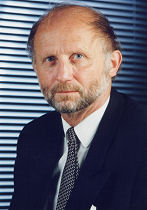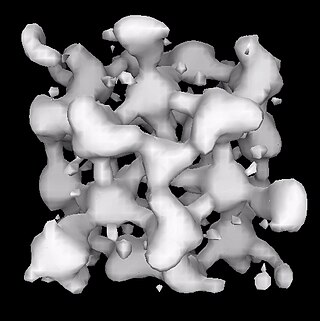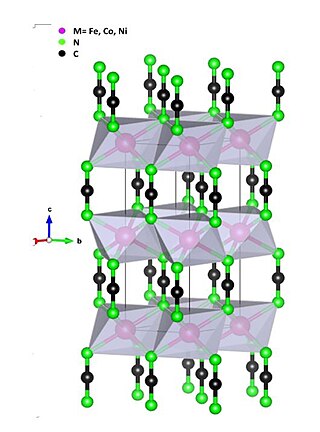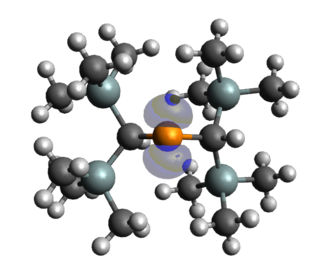Related Research Articles

Benzothiophene is an aromatic organic compound with a molecular formula C8H6S and an odor similar to naphthalene (mothballs). It occurs naturally as a constituent of petroleum-related deposits such as lignite tar. Benzothiophene has no household use. In addition to benzo[b]thiophene, a second isomer is known: benzo[c]thiophene.

Achim Müller was a German chemist. He was Professor Emeritus at the Faculty of Chemistry, University of Bielefeld.

An electride is an ionic compound in which an electron serves the role of the anion. Solutions of alkali metals in ammonia are electride salts. In the case of sodium, these blue solutions consist of [Na(NH3)6]+ and solvated electrons:

Friedrich Asinger was an Austrian chemist and professor for Technical Chemistry. He is well known for his development of a multi-component reaction, the Asinger reaction for the synthesis of 3-thiazolines.
Alexander C. Filippou has been a Professor of Inorganic Chemistry at the Rheinische-Friedrich-Wilhelms-University Bonn since 2005.

Ulrich "Uli" Kortz is a German chemist and professor, working in the area of synthetic polyoxometalate chemistry.

Heribert Offermanns is a German chemist and former member of the board of the Degussa AG.
Michael Pope, was born and educated in England. He received B.A. and D.Phil. degrees from Oxford University. He can be considered as one of the leading and most influential polyoxometalate chemists worldwide. His 1983 book entitled “Heteropoly and Isopoly Oxometalates” is the most cited reference in the field.

Timothy M. Swager is an American Scientist and the John D. MacArthur Professor of Chemistry at the Massachusetts Institute of Technology. His research is at the interface of chemistry and materials science, with specific interests in carbon nanomaterials, polymers, and liquid crystals. He is an elected member of the National Academy of Sciences, American Academy of Arts and Sciences, and the National Academy of Inventors.
Corinna S. Schindler is a Professor of Chemistry at the University of Michigan. She develops catalytic reactions with environmentally benign metals such as iron, towards the synthesis of biologically active small molecules. For her research in the development of new catalysts, Schindler has been honored with several early-career researcher awards including the David and Lucile Packard Foundation Fellowship in 2016, the Alfred P. Sloan Fellowship in 2017, and being named a member of the C&EN Talented 12 in 2017. Schindler has served on the Editorial Board of Organic and Bimolecular Chemistry since 2018.

Helma B. Wennemers is a German organic chemist. She is a professor of organic chemistry at the Swiss Federal Institute of Technology in Zurich.
Paul Knochel is a French chemist and a member of the French Academy of Sciences.

Inorganic carbodiimides (or cyanamides depending on the NCN2- form) design a family of compounds containing the carbodiimide (or cyanamide) anion NCN2- bonded to an inorganic group such as a metal. This anion exhibits pseudochalcogenide character.
Tomislav Friščić holds the Leverhulme International Professorship and Chair in Green and Sustainable chemistry at the University of Birmingham. His research focus is at the interface of green chemistry and materials science, developing solvent-free chemistry and mechanochemistry for the cleaner, efficient synthesis of molecules and materials, including organic solids such as pharmaceutical cocrystals, coordination polymers and Metal-Organic Frameworks (MOFs), and a wide range of organic targets such as active pharmaceutical ingredients. He is a Fellow of the Royal Society of Chemistry (RSC), member of the College of New Scholars, Artists and Scientists of the Royal Society of Canada and a corresponding member of the Croatian Academy of Sciences and Arts. He has served on the Editorial Board of CrystEngComm, the Early Career Board of the ACS journal ACS Sustainable Chemistry & Engineering, and was an Associate Editor for the journal Molecular Crystals & Liquid Crystals as well as for the journal Synthesis. He was a Topic Editor and Social Media Editor, and is currently a member of the Editorial Advisory Board of the journal Crystal Growth & Design published by the American Chemical Society (ACS). He famously has a dog named Zizi.
The borosulfates are heteropoly anion compounds which have sulfate groups attached to boron atoms. Other possible terms are sulfatoborates or boron-sulfur oxides. The ratio of sulfate to borate reflects the degree of condensation. With [B(SO4)4]5- there is no condensation, each ion stands alone. In [B(SO4)3]3- the anions are linked into a chain, a chain of loops, or as [B2(SO4)6]6− in a cycle. Finally in [B(SO4)2]− the sulfate and borate tetrahedra are all linked into a two or three-dimensional network. These arrangements of oxygen around boron and sulfur can have forms resembling silicates. The first borosulfate to be discovered was K5[B(SO4)4] in 2012 by the research group of Henning Höppe, although the compound class as such had been postulated already in 1962 by G. Schott and H. U. Kibbel. Over 80 unique compounds are known as of 2024.

Regina Palkovits is a German chemist who is a Professor of Chemistry at the RWTH Aachen University. Her research considers heterogenous catalysis. She was elected a Fellow of the North Rhine-Westphalian Academy of Sciences, Humanities and the Arts in 2020. In 2023 she was appointed as Director at the Institute for a Sustainable Hydrogen Economy (INW) at Forschungszentrum Jülich.
A nitridophosphate is an inorganic compound that contains nitrogen bound to a phosphorus atom, considered as replacing oxygen in a phosphate.
Corundum is the name for a structure prototype in inorganic solids, derived from the namesake polymorph of aluminum oxide (α-Al2O3). Other compounds, especially among the inorganic solids, exist in corundum structure, either in ambient or other conditions. Corundum structures are associated with metal-insulator transition, ferroelectricity, polar magnetism, and magnetoelectric effects.

Stable and persistent phosphorus radicals are phosphorus-centred radicals that are isolable and can exist for at least short periods of time. Radicals consisting of main group elements are often very reactive and undergo uncontrollable reactions, notably dimerization and polymerization. The common strategies for stabilising these phosphorus radicals usually include the delocalisation of the unpaired electron over a pi system or nearby electronegative atoms, and kinetic stabilisation with bulky ligands. Stable and persistent phosphorus radicals can be classified into three categories: neutral, cationic, and anionic radicals. Each of these classes involve various sub-classes, with neutral phosphorus radicals being the most extensively studied. Phosphorus exists as one isotope 31P (I = 1/2) with large hyperfine couplings relative to other spin active nuclei, making phosphorus radicals particularly attractive for spin-labelling experiments.
René Peters is a German chemist and since 2008 Professor of Organic Chemistry at the University of Stuttgart.
References
- 1 2 3 4 5 "CV Dronskowski" (PDF). www.ssc.rwth-aachen.de. Retrieved 2018-12-30.
- 1 2 3 4 "Richard Dronskowski". Angewandte Chemie International Edition. 54 (31): 8872. 2015. doi:10.1002/anie.201502594. ISSN 1521-3773. PMID 25851434.
- 1 2 "Hoffmann Institute for Advanced Materials • GuestProfessor". hiam.szpt.edu.cn. Retrieved 2018-12-30.
- ↑ "Distinguished Professorships – RWTH AACHEN UNIVERSITY – Deutsch". www.rwth-aachen.de. Retrieved 2018-12-30.
- ↑ "Innovation Award der RWTH zeichnet vielfältige Ideen aus – RWTH AACHEN UNIVERSITY – Deutsch". www.rwth-aachen.de. Retrieved 2018-12-30.